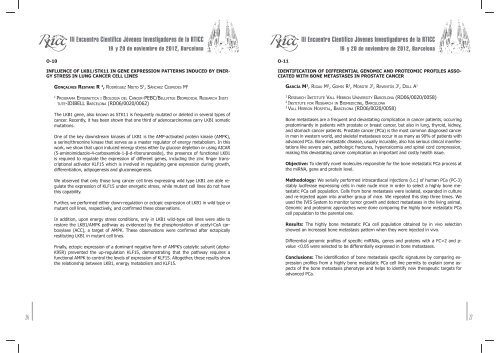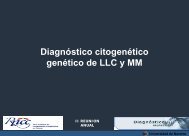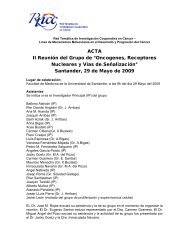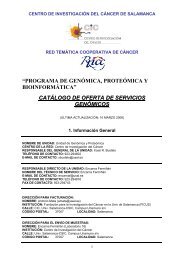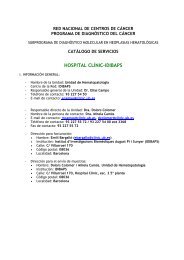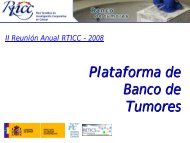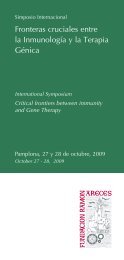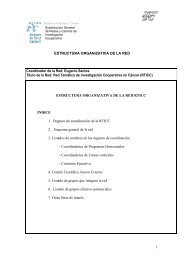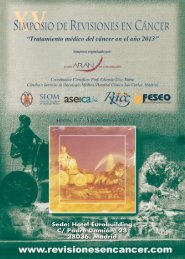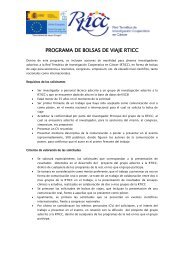Untitled - Red Temática de investigación cooperativa en cáncer
Untitled - Red Temática de investigación cooperativa en cáncer
Untitled - Red Temática de investigación cooperativa en cáncer
You also want an ePaper? Increase the reach of your titles
YUMPU automatically turns print PDFs into web optimized ePapers that Google loves.
O-10<br />
INFLUENCE OF LKB1/STK11 IN GENE EXPRESSION PATTERNS INDUCED BY ENER-<br />
GY STRESS IN LUNG CANCER CELL LINES<br />
GONÇALVES RESTANI R 1 , RODRÍGUEZ NIETO S 1 , SÁNCHEZ CESPEDES M 1<br />
1<br />
PROGRAMA EPIGENETICA I BIOLOGIA DEL CANCER-PEBC/BELLVITGE BIOMEDICAL RESEARCH INSTI<br />
TUTE-IDIBELL BARCELONA (RD06/0020/0062)<br />
The LKB1 g<strong>en</strong>e, also known as STK11 is frequ<strong>en</strong>tly mutated or <strong>de</strong>leted in several types of<br />
cancer. Rec<strong>en</strong>tly, it has be<strong>en</strong> shown that one third of a<strong>de</strong>nocarcinomas carry LKB1 somatic<br />
mutations.<br />
One of the key downstream kinases of LKB1 is the AMP-activated protein kinase (AMPK),<br />
a serine/threonine kinase that serves as a master regulator of <strong>en</strong>ergy metabolism. In this<br />
work, we show that upon induced <strong>en</strong>ergy stress either by glucose <strong>de</strong>pletion or using AICAR<br />
(5-aminoimidazole-4-carboxami<strong>de</strong>-1-β-d-riboruranosi<strong>de</strong>), the pres<strong>en</strong>ce of functional LKB1<br />
is required to regulate the expression of differ<strong>en</strong>t g<strong>en</strong>es, including the zinc finger transcriptional<br />
activator KLF15 which is involved in regulating g<strong>en</strong>e expression during growth,<br />
differ<strong>en</strong>tiation, adipog<strong>en</strong>esis and gluconeog<strong>en</strong>esis.<br />
We observed that only those lung cancer cell lines expressing wild type LKB1 are able regulate<br />
the expression of KLF15 un<strong>de</strong>r <strong>en</strong>ergetic stress, while mutant cell lines do not have<br />
this capability.<br />
Further, we performed either down-regulation or ectopic expression of LKB1 in wild type or<br />
mutant cell lines, respectively, and confirmed these observations.<br />
In addition, upon <strong>en</strong>ergy stress conditions, only in LKB1 wild-type cell lines were able to<br />
restore the LKB1/AMPK pathway as evi<strong>de</strong>nced by the phosphorylation of acetyl-CoA carboxylase<br />
(ACC), a target of AMPK. These observations were confirmed after ectopically<br />
restituting LKB1 in mutant cell lines.<br />
Finally, ectopic expression of a dominant negative form of AMPK’s catalytic subunit (alpha-<br />
K95R) prev<strong>en</strong>ted the up-regulation KLF15, <strong>de</strong>monstrating that the pathway requires a<br />
functional AMPK to control the levels of expression of KLF15. Altogether, these results show<br />
the relationship betwe<strong>en</strong> LKB1, <strong>en</strong>ergy metabolism and KLF15.<br />
O-11<br />
IDENTIFICATION OF DIFFERENTIAL GENOMIC AND PROTEOMIC PROFILES ASSO-<br />
CIATED WITH BONE METASTASES IN PROSTATE CANCER<br />
GARCÍA M 1 , RIGAU M 1 , GOMIS R 2 , MOROTE J 3 , REVENTÓS J 1 , DOLL A 1<br />
1<br />
RESEARCH INSTITUTE VALL HEBRON UNIVERSITY BARCELONA (RD06/0020/0058)<br />
2<br />
INSTITUTE FOR RESEARCH IN BIOMEDICINE, BARCELONA<br />
3<br />
VALL HEBRON HOSPITAL, BARCELONA (RD06/0020/0058)<br />
Bone metastases are a frequ<strong>en</strong>t and <strong>de</strong>vastating complication in cancer pati<strong>en</strong>ts, occurring<br />
predominantly in pati<strong>en</strong>ts with prostate or breast cancer, but also in lung, thyroid, kidney,<br />
and stomach cancer pati<strong>en</strong>ts. Prostate cancer (PCa) is the most common diagnosed cancer<br />
in m<strong>en</strong> in western world, and skeletal metastases occur in as many as 90% of pati<strong>en</strong>ts with<br />
advanced PCa. Bone metastatic disease, usually incurable, also has serious clinical manifestations<br />
like severe pain, pathologic fractures, hypercalcemia and spinal cord compression,<br />
making this <strong>de</strong>vastating cancer complication an important and costly health issue.<br />
Objective: To i<strong>de</strong>ntify novel molecules responsible for the bone metastatic PCa process at<br />
the miRNA, g<strong>en</strong>e and protein level.<br />
Methodology: We serially performed intracardiacal injections (i.c.) of human PCa (PC-3)<br />
stably luciferase expressing cells in male nu<strong>de</strong> mice in or<strong>de</strong>r to select a highly bone metastatic<br />
PCa cell population. Cells from bone metastasis were isolated, expan<strong>de</strong>d in culture<br />
and re-injected again into another group of mice. We repeated this step three times. We<br />
used the IVIS System to monitor tumor growth and <strong>de</strong>tect metastases in the living animal.<br />
G<strong>en</strong>omic and proteomic approaches were done comparing the highly bone metastatic PCa<br />
cell population to the par<strong>en</strong>tal one.<br />
Results: The highly bone metastatic PCa cell population obtained by in vivo selection<br />
showed an increased bone metastasis pattern wh<strong>en</strong> they were injected in vivo.<br />
Differ<strong>en</strong>tial g<strong>en</strong>omic profiles of specific miRNAs, g<strong>en</strong>es and proteins with a FC>2 and p-<br />
value


